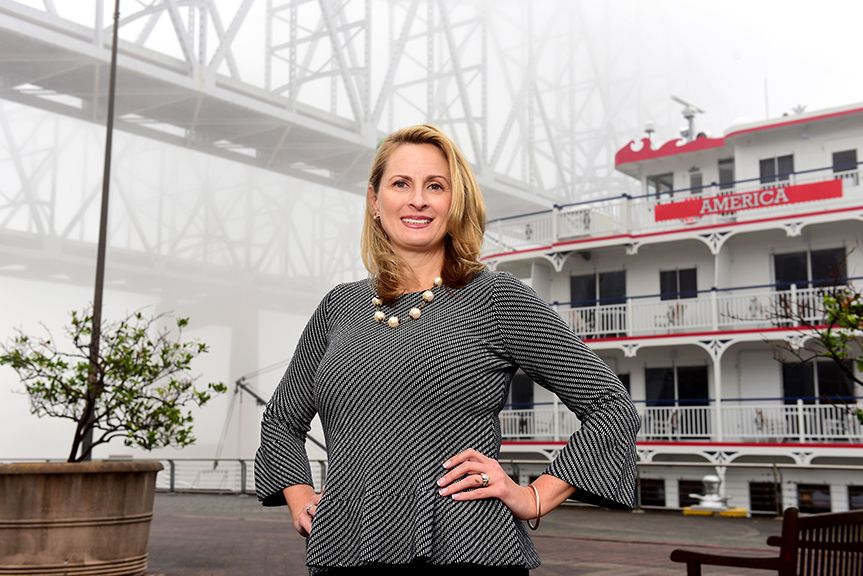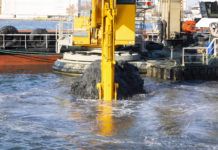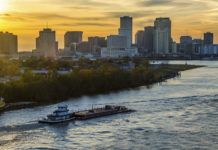During her tenure as the Port of San Diego’s vice president of strategy and business development, Brandy Christian proved she had that unique combination of analytical and soft skills to land the “big fish,” namely by salvaging the port’s floundering cruise ship industry and securing a crucial lease with Dole Fresh Foods.
Ultimately, it was her tenacity that persuaded the Port of New Orleans to appoint Christian as COO in 2015, with plans to groom her as the next president and CEO. She was officially named to that position at the beginning of this year, following the retirement of maritime veteran Gary LaGrange.
A big believer in strategic planning and organizational processes, Christian has already begun instituting an ongoing strategic planning initiative to enable the port to swiftly refocus and reprioritize in response to changing market conditions. “I tend to be a dreamer in terms of looking at the long view and having big goals,” Christian says. “I’m also very practical. I can focus on strategy and be cognizant of the details.”
She’s no stranger to challenges along the way. While she was in San Diego, a downturn in the cruise business caused by rising crime levels in Cabo, Mazatlán and the Mexican Riviera made for some tough times for the West Coast cruise industry. In the midst of the downturn, one of Christian’s primary objectives was to secure Disney Cruise Line as the company considered competing ports in San Diego and Los Angeles.
In the end, she was successful in landing the mega cruise line.
“Customer service was a big thing. For a line such as Disney, that’s very important,” she says. “A lot went into getting feedback from them and from other lines about how we could improve our service and the customer experience, then following up by making those improvements in the facility, our staffing, our partnerships, etc.”
Through that experience, Christian learned the inherent value of collaboration between public and private entities, something she carried with her to New Orleans. Securing big business makes her most proud, wherever she’s working. “It’s much like securing a new airline service for a city,” she says. “You’ll have the city, mayor, economic development people, police, tourism officials, etc., all come to the table. The port is a critical factor because we deliver the infrastructure to make it happen.”
Michael Hecht, president and CEO of regional economic development agency GNO Inc., has worked closely with Christian on multiple economic development projects in the past year, and says she’s the right person at the right time.
“I think that as the port considers its next stage of growth, she’ll be an outstanding leader because she combines experience in the industry with a strategic mindset and an already demonstrated ability to move projects forward,” Hecht says. “Under Brandy’s leadership, it’s our expectation that the relationship with the port, which was already strong, is only going to become more dynamic.”
As evidence of this strong bond, incoming GNO Inc. Board Chairman Tara Hernandez was recently appointed to the port’s board of commissioners.
Port master plan takes shape
One of Christian’s most immediate tasks will be the continued development of the port’s master plan, Port NOLA 2025, which seeks to identify those projects necessary to meet port needs in the next decade, as determined by market forecasts and demand analysis.
In 2016, the port reached out to current customers and communities across its jurisdiction to begin the process of gathering input and identifying challenges and weaknesses.
“As a next step, we’ll dig down and ask some key questions: Can our existing facilities handle the demand? What would we need in the way of new facilities?” she says. “That’s the nuts and bolts of it over the next six months … understanding and prioritizing.”
Ultimately, the projects that make the final cut will be those that provide the most bang for the buck. One such opportunity involves securing direct liner service on an international scale, which has seen some recent successes. In December, France-based CMA CGM announced a new direct weekly container service to Asia from the Napoleon Avenue Container Terminal. The faster transit times provided by the new direct service enhances the port’s reach for shippers, as well as strengthens its overall competitive advantage. It also helps both the region and state by serving as a catalyst to attract new business.
Input from Louisiana’s petrochemical industry has been essential to the development of Port NOLA 2025. “The petrochemical, oil and gas industries have provided a great catalyst in terms of our cargo growth,” Christian says. “I think it’s important that we look beyond our footprint and look where we’re adding value. That gives the state the opportunity to say, ‘We’ve got these ports to be able to provide a service to move your goods.’”
Most recently, the port has begun exploring new purposes for the shuttered Avondale shipyard. Now two years after the facility closed, the port is hopeful that the site will soon be resurrected. The shipyard, with its nearly 200 acres and more than 7,900 feet of riverfront access, was once one of the state’s biggest employers.
Hecht says GNO Inc. has been heavily involved in finding prospective investors at Avondale. “For the next year, we plan to focus on value-added manufacturing at the site,” he adds. “It’s a very exciting prospect. As a region, we haven’t done a good job in that area; we’ve been mostly commodity based. Avondale gives us a chance to take those commodities and add value here. For example, that could mean taking rubber shipped to the port and turning it into tires, or taking pellets and manufacturing plastic products.”
Christian and other port officials have spoken with potential private sector partners to determine market demand and examine the feasibility of using the facility based upon existing site conditions. “If you look at the New Orleans port, we usually rank in the top three for major things such as rubber and steel,” she says. “However, a lot of that product is coming in and out across our docks, then gets shipped off to another state to be made into a tire. Avondale has some great manufacturing warehouses and equipment—could we take some of those products and create new cargo or new demand?”
Topping the list of potential value-added products is steel pipe fabrication for the offshore oil industry, given that a significant amount of steel is currently shipped into the port, yet goes elsewhere for fabrication.
A streamlined approach
Improved operational efficiency has been another goal for Christian in her first weeks as CEO. The result has been a complete restructuring of administrative departments, with a focus on streamlining port processes.
“What I’ve tried to do is take departments that are like-focused and help them synergize their efforts,” she adds. “For the most part, it’s about aligning them toward a strategy. In some cases, it involved taking current executives and giving them more responsibilities, responsibilities for things that would help them get their jobs done better.”
In the process, Christian has leaned heavily upon her strengths. While in San Diego she was the driving force behind streamlining the port’s operational processes, reducing costs, securing major accounts and negotiating leases.
“I come from a quality management background,” she says. “In previous positions, my job was to look at process operations: How do we fine tune? How do we streamline? I led several IT implementations. What’s important to me is building a culture of excellence. I feel it’s important as a public agency that we are not just the most efficient, but the most effective that we can be.”
The port is also investing in automation across multiple departments, such as finance, human resources and procurement. Procurement will perhaps be most affected—Christian is spearheading an effort to not only automate the procurement process, but “think through how we open up opportunity. How do we make the broader community know that there’s an opportunity to work with the port?”
Christian notes procurement used to be a de-centralized process. “Now, we actually have a director of procurement with a background in small business outreach to actually go out to the communities and start building these programs,” she says.
In the end, Christian hopes that more customer-port interactions will be conducted online rather than via paperwork.
Originally published in the first quarter 2017 edition of 10/12 Industry Report.








